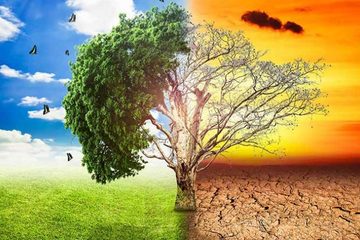We found 8 results that contain "earth"
Posted on: #iteachmsu


Mapping the global threat of land subsidence
Subsidence, the lowering of Earth's land surface, is a potentially destructive hazard that can be caused by a wide range of natural or anthropogenic triggers but mainly results from solid or fluid mobilization underground. Subsidence due to groundwater depletion (1) is a slow and gradual process that develops on large time scales (months to years), producing progressive loss of land elevation (centimeters to decimeters per year) typically over very large areas (tens to thousands of square kilometers) and variably affects urban and agricultural areas worldwide. Subsidence permanently reduces aquifer-system storage capacity, causes earth fissures, damages buildings and civil infrastructure, and increases flood susceptibility and risk.
Posted on: #iteachmsu


The causes, effects, and complexities of global warming are important to understand so that we can f
Global warming is the long-term warming of the planet’s overall temperature. Though this warming trend has been going on for a long time, its pace has significantly increased in the last hundred years due to the burning of fossil fuels. As the human population has increased, so has the volume of fossil fuels burned. Fossil fuels include coal, oil, and natural gas, and burning them causes what is known as the “greenhouse effect” in Earth’s atmosphere.
The greenhouse effect is when the sun’s rays penetrate the atmosphere, but when that heat is reflected off the surface cannot escape back into space. Gases produced by the burning of fossil fuels prevent the heat from leaving the atmosphere. These greenhouse gasses are carbon dioxide, chlorofluorocarbons, water vapor, methane, and nitrous oxide. The excess heat in the atmosphere has caused the average global temperature to rise overtime, otherwise known as global warming.
Global warming has presented another issue called climate change. Sometimes these phrases are used interchangeably, however, they are different. Climate change refers to changes in weather patterns and growing seasons around the world. It also refers to sea level rise caused by the expansion of warmer seas and melting ice sheets and glaciers. Global warming causes climate change, which poses a serious threat to life on Earth in the forms of widespread flooding and extreme weather. Scientists continue to study global warming and its impact on Earth.
The greenhouse effect is when the sun’s rays penetrate the atmosphere, but when that heat is reflected off the surface cannot escape back into space. Gases produced by the burning of fossil fuels prevent the heat from leaving the atmosphere. These greenhouse gasses are carbon dioxide, chlorofluorocarbons, water vapor, methane, and nitrous oxide. The excess heat in the atmosphere has caused the average global temperature to rise overtime, otherwise known as global warming.
Global warming has presented another issue called climate change. Sometimes these phrases are used interchangeably, however, they are different. Climate change refers to changes in weather patterns and growing seasons around the world. It also refers to sea level rise caused by the expansion of warmer seas and melting ice sheets and glaciers. Global warming causes climate change, which poses a serious threat to life on Earth in the forms of widespread flooding and extreme weather. Scientists continue to study global warming and its impact on Earth.
DISCIPLINARY CONTENT
Posted on: #iteachmsu


Mapping the global threat of land subsidence
Subsidence, the lowering of Earth's land surface, is a potentially destructive hazard that can be caused by a wide range of natural or anthropogenic triggers but mainly results from solid or fluid mobilization underground. Subsidence due to groundwater depletion (1) is a slow and gradual process that develops on large time scales (months to years), producing progressive loss of land elevation (centimeters to decimeters per year) typically over very large areas (tens to thousands of square kilometers) and variably affects urban and agricultural areas worldwide. Subsidence permanently reduces aquifer-system storage capacity, causes earth fissures, damages buildings and civil infrastructure, and increases flood susceptibility and risk.
Posted on: #iteachmsu


Global Warming (Globalization)
Global warming is a term used for the observed century-scale rise in the average temperature of the Earth's climate system and its related effects. Scientists are more than 95% certain that nearly all of global warming is caused by increasing concentrations of greenhouse gases (GHGs) and other human-caused emissions.
NAVIGATING CONTEXT
Posted on: #iteachmsu


Measuring Global Ocean Heat Content to Estimate the Earth Energy Imbalance
Estimating and analyzing the Earth Energy Imbalance (EEI) is essential for understanding the evolution of the Earth’s climate. This is possible only through a careful computation and monitoring of the climate-energy budget. The climate system exchanges energy with outer space at the top of the atmosphere (TOA) (through radiation) and with solid Earth at the Earth’s crust surface (essentially through geothermal flux). If the climate system were free from external perturbations and internal variability during millennia, then the climate-energy budget would be in a steady state in which the net TOA radiation budget compensates the geothermal flux of +0.08 Wm–2 (Davies and Davies, 2010).
But the climate system is not free from external perturbations and from internal variability. Although the geothermal flux does not generate any perturbations at interannual to millennial time scales (because it varies only at geological time scales), other external forcings from natural origin (such as the solar radiation, the volcanic activity) or anthropogenic origin (such as Greenhouse Gas emissions –GHG-) perturb the system.
REf:https://www.frontiersin.org/articles/10.3389/fmars.2019.00432/full
But the climate system is not free from external perturbations and from internal variability. Although the geothermal flux does not generate any perturbations at interannual to millennial time scales (because it varies only at geological time scales), other external forcings from natural origin (such as the solar radiation, the volcanic activity) or anthropogenic origin (such as Greenhouse Gas emissions –GHG-) perturb the system.
REf:https://www.frontiersin.org/articles/10.3389/fmars.2019.00432/full
Posted by: Chathuri Hewapathirana
Disciplinary Content
Posted on: #iteachmsu


Global Warming
Earth has warmed and cooled time and again. Climate has changed when the planet received more or less sunlight due to subtle shifts in its orbit, as the atmosphere or surface changed, or when the Sun’s energy varied. But in the past century, another force has started to influence Earth’s climate: humanity
How does this warming compare to previous changes in Earth’s climate? How can we be certain that human-released greenhouse gases are causing warming? How much more will the Earth warm? How will Earth respond? Answering these questions is perhaps the most significant scientific challenge of our time.
What is Global Warming?
Global warming is the unusually rapid increase in Earth’s average surface temperature over the past century primarily due to the greenhouse gases released as people burn fossil fuels. The global average surface temperature rose 0.6 to 0.9 degrees Celsius (1.1 to 1.6° F) between 1906 and 2005, and the rate of temperature increase has nearly doubled in the last 50 years.
How does this warming compare to previous changes in Earth’s climate? How can we be certain that human-released greenhouse gases are causing warming? How much more will the Earth warm? How will Earth respond? Answering these questions is perhaps the most significant scientific challenge of our time.
What is Global Warming?
Global warming is the unusually rapid increase in Earth’s average surface temperature over the past century primarily due to the greenhouse gases released as people burn fossil fuels. The global average surface temperature rose 0.6 to 0.9 degrees Celsius (1.1 to 1.6° F) between 1906 and 2005, and the rate of temperature increase has nearly doubled in the last 50 years.
Authored by: Rupali
Assessing Learning
Posted on: #iteachmsu


Global warming
Global warming is the long-term heating of Earth's climate system observed since the pre-industrial period (between 1850 and 1900) due to human activities, primarily fossil fuel burning, which increases heat-trapping greenhouse gas levels in Earth's atmosphere.
Authored by: admin
Posted on: #iteachmsu


It’s easy to think nature will always be with us.
it depends on whether we let nature go to the wall or act to repair, restore, and maintain it. Right now species are going extinct and the natural systems that support all life on Earth are being eroded faster than ever before.
Even once common species like bees, hedgehogs, starlings and house sparrows are in trouble – going missing from our streets and neighbourhoods. The bees and birds lose out big time – and so do we.
it depends on whether we let nature go to the wall or act to repair, restore, and maintain it. Right now species are going extinct and the natural systems that support all life on Earth are being eroded faster than ever before.
Even once common species like bees, hedgehogs, starlings and house sparrows are in trouble – going missing from our streets and neighbourhoods. The bees and birds lose out big time – and so do we.
Posted by: Rupali Jagtap
Assessing Learning
